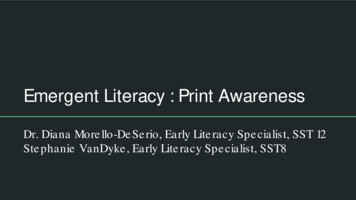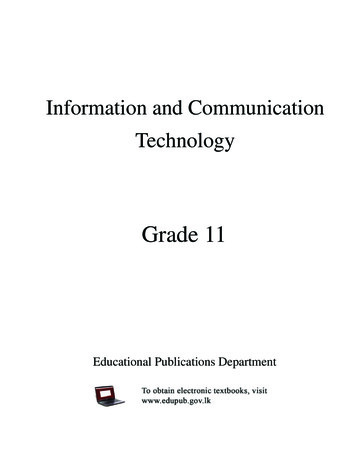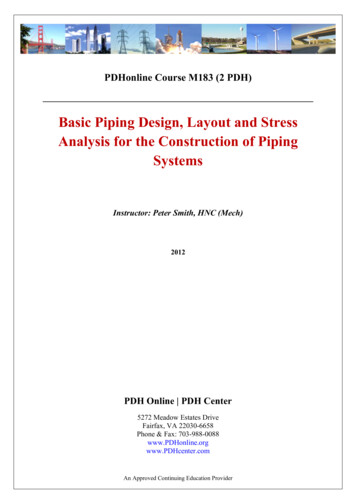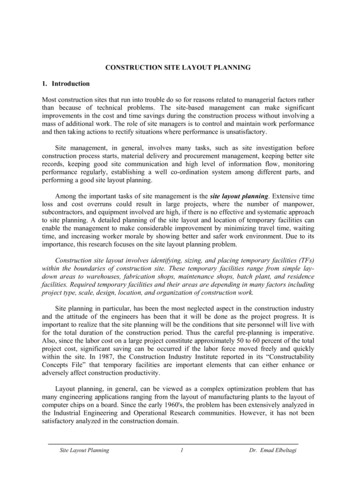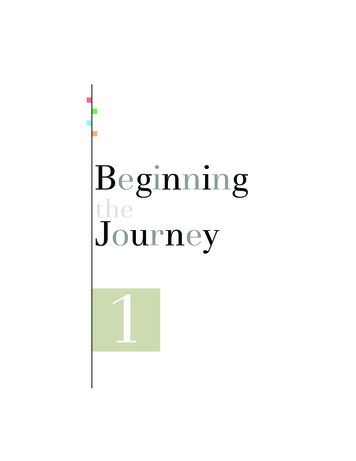
Transcription
BeginningtheJourney1
Setting the StageWe literally live in a global village. All around us are images,sounds, and even smells of people with racial, ethnic, cultural,and religious backgrounds other than our own. We see it in ourshopping malls, along our market streets, on the informationsuperhighway, on the television, at the movies, in our schools,and, perhaps, even in our homes. We hear it on our streets, inour buses, at the stadium, and on our radios. As a high schoolstudent, you live in a somewhat protected environment withadult guardians to help guide you. Once you leave high school,however, you are on your own as you encounter the world as anadult. One of the major roles of high school is to prepare itsstudents to live as responsible, thinking, productive, loving,active Catholic adults in a very diverse global village.Religious diversity abounds in our world. It is most prevalent in large cities. Just look at London, Sydney, Montreal,Toronto, Paris, Frankfurt, Johannesburg, Bombay, Singapore,New York, Los Angeles, San Francisco, and Chicago. Thereligious diversity is more the richer because one may find notonly Buddhists in many of these mentioned cities, but7
8Exploring the Religions of Our WorldBuddhists from such diverse places as Japan, India, andVietnam. Not only can Christians be found in all these places,but they may be Roman Catholics, Chaldean Catholics, RussianOrthodox, Church of England, German Lutherans, andSouthern Baptists.This is not just another religion textbook. This book isabout religion itself. In other religion classes, you learned aboutone particular religious tradition. In studying Christianity andspecifically Catholicism, you most likely took classes on suchtopics as Jesus of Nazareth, the Hebrew Scriptures, the NewTestament, Sacraments, Morality, Justice and Peace, andChurch History. A class on the world’s religions is different.Rather than an in-depth study of one religious tradition, thisclass is an overview of religious traditions other than, yetincluding, Catholicism. This book challenges Catholic studentsto proclaim in word and deed Jesus Christ as the way, the truth,and the light and, through the inspiration of the Holy Spirit,dialogue with and learn from other religious traditions.You are probably familiar with the term “world religions.” Itrefers to those religious traditions that are worldwide such asBuddhism, Christianity, and Islam.Adherents to world religions canbe found on most continents, thatis, in the northern, southern, eastern, and western parts of the globe.In this class, you will study worldwide religious traditions. In addition, you will study religioustraditions that have great significance, but are not as widespread.For example, you will studyHinduism. While 95 percent ofHindus live on the subcontinent ofIndia, the other five percent live inother parts of the globe. Among other things, Hinduism’s significance can be seen in its great number of adherents as well asthe fact that it is foundational in the rise of Buddhism.
Beginning the Journey zOf what religious diversity are youaware in your geographic region?zBefore reading further, how would youdefine religion?What Is Religion?Though we glibly use the word religion, the vast majority ofscriptures used by the various religions, including the Bible, donot even have the word “religion” in them. Until modern times,religion was not separated from the rest of life. In birth anddeath, work and play, relationships with people, and connections with nature, what we now call religion was once—and formany cultures still is—all wrapped up in the fabric of life.Even now a definition of religion is elusive. It is derivedfrom the Latin word religio, meaning “to bind.” Under thename of religion, a person or community “bound” itself tosomething that was worthy of reverence or respect. Generally,certain obligations came along with this willingness to havestrong ties with that which was over and beyond them. Askingpeople to define religion, we hear phrases like “worshippingGod,” “living a moral life,” or “one’s belief system.” Religion isnot just one thing. Imagining the many aspects of the world’sreligions, the spectrum of religious expression is boundless. Why Study the World’s Religions?You may wonder, “If religion cannot be defined and if religiousexpression is boundless, why study the various religions?” This is afair question. Until very recently, the study of religion was a peculiarly Western discipline. At first glance, it may seem impossible toget a handle on what has already been described above as elusive. On the other hand, there are some patterns or elementsthat could be included in a systematic study of religion.Reasons to study the world’s religions include the following:9
10Exploring the Religions of Our World To gain a clearer understanding of one’s own faith,which in turn enables a person to be more committedto and thus grow in his or her own religious tradition. To assist a person in being more open and acceptingof people who, on the surface, seem very different. To dispel fears and misunderstandings relating topersons of other religious traditions. To gain a better insight into human beings by understanding their religious activities. To gain a better understanding of the history ofhumankind’s various civilizations, since religion isalmost always an important factor. To gain a better understanding of the various cultures around the globe today. To learn from some of the world’s great sources ofwisdom.z Which of the listed reasons bestdescribe why you are studying theworld’s religions?A Different Religion ClassAs you no doubt have already experienced, religion classes aredifferent from any other class. Putting it succinctly, a religionclass calls upon learning in both the head and the heart. Morethan any other class, religion classes call upon one to deal withfacts and experiences. Like other subjects, religion does deal withthe rational. Unlike other subjects, topics such as life and death,good and evil, love and hate, joy and sorrow, and questions likewhere we came from, why we are here, and where we are going areintegral to religion classes. What is unique about studying theworld’s religions as compared to studying one’s own religion isthat each religious tradition addresses and interprets these, andother experiences, differently.
11Beginning the JourneyStudying with a New AttitudeAs students of the world’s religions, we are asked not topass judgment upon the various religious traditions. As the documents of the Second Vatican Council state:The Catholic Church rejects nothing which is true andholy in these religions. She looks with sincere respectupon those ways of conduct and of life, those rulesand teaching which, though differing in many particulars from what she holds and sets forth, neverthelessoften reflect a ray of that Truth which enlightens all(Nostra Aetate, 2).We are asked to suspend judgment as to the truth claims ofa religious tradition and accept the tradition on its own terms.Not only does Catholicism have something to teach other religious traditions, but all of the religions that we will study havesomething to teach us. We areasked to engender an attitude ofempathy. The word “empathy”means to identify and understandthe situation of another. In otherwords, as we study some of theworld’s religions, we are asked—toparaphrase a Native Americanproverb—to “walk a mile in themoccasins of another. ”We are not asked to accept whatothers believe and practice. Rather,we are asked to be humble, open,and respectful. As Joseph Ratzinger, now Pope Benedict XVI,wrote, “Equality, which is a presupposition of interreligiousdialogue, refers to the equal personal dignity of the parties indialogue . . .” (Dominus Jesus, #22). Pope John Paul II alsoemphasized this attitude in his encyclical Redemptoris Missio:Those engaged in this dialogue must be consistent with theirown religious traditions and convictions, and be open to understanding those of the other party without pretense or closedmindedness, but with truth, humility and frankness, knowing
12Exploring the Religions of Our Worldthat dialogue can enrich each side. There must be no abandonment of principles or false irenicism, but instead a witnessgiven and received for mutual advancement on the road of religious inquiry and experience, and at the same time for the elimination of prejudice, intolerance and misunderstandings.Dialogue leads to inner purificationand conversion which, if pursuedwith docility to the Holy Spirit, willbe spiritually fruitful. (56)When our journey is completed,we are able to return with moreinsight into our Catholic faith, which“proclaims and must ever proclaimChrist, ‘the way, the truth and thelife’ (John 14:6), in whom we find thefullness of religious life, and inwhom God has reconciled all thingsto himself” (cf. 2 Cor 5:18–19).1 Setting the Context ofCatholics in DialogueBefore becoming Pope John XXIII, Angelo Roncalli was aVatican diplomat to Turkey and Greece. There he was in contact with Greek Orthodox Christians and Muslims. DuringWorld War II, Roncalli helped thousands of Jews escape deathunder the Nazis. As Pope John, he continued to work towardChristian unity. In his first encyclical, Ad Cathedram Petri, PopeJohn XXIII referred to Protestants as “separated brethren”rather than heretics. After centuries of strained relationsbetween Catholics and Anglicans and Catholics and EasternOrthodox, the pope received the Archbishop of Canterbury,Geoffrey Fisher, at the Vatican and sent a delegation to greet thePatriarch of Constantinople, Athanagoras I.Pope John was interested not only in improving relationsbetween Catholics and other Christians. With his deep affection and respect for the Jewish people, Pope John XXIII had theegregiously offensive language of praying for the “perfidious
13Beginning the JourneyJews” removed from the Good Friday liturgyliturgy. Rejection of the Jews was laterA definite set of formssoundly denounced during the Secondfor public religious worVatican Council (Notra Aetate 4; cf. CCC,ship. Liturgy is the offi839).cial public worship ofThese gestures of respect for personsthe Church. The Sevenof other religious traditions may seemSacraments, especiallyminor today, but in the early 1960s, theythe Eucharist, are thewere tremendously significant. Before theprimary forms of liturpontificate of Pope John XXIII, Catholicsgical celebrations.were not allowed to step foot in aProtestant church other than to attend a funeral. As late as1960, one could still hear and read Catholic leaders callingProtestants “heretics,” Eastern Orthodox Christians “schismatics,” Muslims “infidels,” and Jews “Christ killers.”It was Pope John XXIII’s vision that the Catholic Churchnot set itself against the world, but engage in dialogue with theworld. Dialoguing with people of various religious traditionswas part of that vision. With the promulgation of the SecondVatican Council in October, 1962, Pope John wanted it to be atruly Ecumenical Council. To that end, not only were thereover 2,200 bishops from across the world in attendance atthe opening session, but a number of leaders from other religious traditions were invited as observers of the Council. Inattendance were Protestant, Anglican, Eastern Orthodox, andJewish leaders. Pope John XXIII died after the convening ofonly one of the four sessions of the Second Vatican Council.His successor, Pope Paul VI, and the bishops of the Councilcontinued in the direction of Pope John XXIII’s vision.Benefits of the CouncilThree of the sixteen documents that came out of theSecond Vatican Council set an impetus for Catholics to dialogue with other Christians and non-Christians alike. TheDeclaration on Human Freedom (Dignitatis Humanae) addresses the right of the individual to social and civil freedom withregard to religious matters. The Decree on Ecumenism (Unitates
14Exploring the Religions of Our WorldRedintegratio) speaks to the Catholic Church’s relationship withother Christians, while the relations with non-Christian religious traditions is spoken to in the Declaration on the Relationof the Church to Non-Christian Religions (Nostra Aetate).The words of these documents are extremely important insetting Catholics on a path to respect and dialogue with personsnot of their religious persuasion. The pontificates of PopesPaul VI and John Paul II put the words and spirit of these documents into action by following and expanding on the exampleof Pope John XXIII.ecumenismFor example, Pope Paul VI was veryinterested in ecumenism and religiousThe movement,freedom.He not only met with theinspired and led by thePatriarchofConstantinople, AthanagorasHoly Spirit, that seeksI, but they issued a joint resolution at thethe union of allend of the Council in December, 1965,Christian faiths andregretting the mutual excommunicationeventually the unity ofof 1054. Pope Paul met with twoall peoples throughoutArchbishops of Canterbury, Michaelthe world.Ramsey and Donald Cogan. With the latter, they issued a joint declaration to seek unity.Pope John Paul II was the most traveled pope in history. Onhis visits, he made it a point to sit down and talk with the various religious leaders of the region. In 1986 and again in 2002 heinvited religious leaders from all over the world to Assisi, Italy,for a World Day of Prayer for Peace. John Paul II was the firstpope since St. Peter, as far as history can tell, to visit a synagogue. He was the first pope to visit a mosque as he did inDamascus, Syria. He supported serious theological dialoguewith Lutherans resulting in a document called the JointDeclaration on the Doctrine of Justification. Serious about healingthe wounds between Catholicism and Eastern Orthodoxchurches, Pope John Paul II worked mightily for that cause. Thesuccess of Pope John Paul II’s outreach to members of religiouscommunities all over the world can be seen by the number anddiversity of religious leaders who attended his funeral at theVatican in April, 2005.
Beginning the Journey15Ecumenical Dialogue Is a Duty of All CatholicsAs people baptized in Christ Jesus, all Catholics are called toevangelize the world (CCC, 849). In the most common usage ofthe word, evangelization is understood asevangelizationdesiring to convert others to CatholicFrom the root word forChristianity. Yet, we live in a world of“gospel,” the “sharinggreat religious diversity, full of peopleof the Good News.”with their own strong religious convictions. How can Catholics engage in dialogue with persons of other religious traditions without theexpectation that one must try to convert them? The CatholicChurch is very clear that there is no conwitnessingflict in dialogue and proclamation. In diaGiving testimony oflogue, Catholics are evangelizing byone’s religious faith towitnessing to their faith without the needanother.of trying to get people to change their religious allegiance.God, who is the Father of all, offers the gift of salvation toall the nations. Through the grace of the Holy Spirit, who isalso at work outside the visible limits of the Church, people inevery part of the world seek to adore God in an authentic way.The scriptures of other religions point to a future of communion with God, of purification and salvation, and theyencourage people to seek the truth and defend the values of life,holiness, justice, peace, and freedom. When Christians engage ininterreligious dialogue, they bring with them their faith in JesusChrist, the only Savior of the world. This same faith teachesthem to recognize the authentic religious experiences of othersand to listen to them in a spirit of humility, in order to discoverand appreciate every ray of truth from wherever it comes. (SeeJohn Paul II, General Audience, November 29, 2000.) He established the Church as the ordinary means of salvation becausethe Church possesses the fullness of the means of salvation(CCC, 846). In July 2007 Pope Benedict XVI issued a statementthat reiterated the primacy of the Catholic Church because ofits apostolic succession by which it can offer the “means of salvation.” While this statement attracted some negative reaction
16Exploring the Religions of Our Worldin the secular media, a spokesperson for the Vatican emphasizedthat the Church was “not backtracking on ecumenical commitment.” The church teaches that people from other religious traditions, too, can be recipients of God’s grace (CCC,847). JesusChrist is the Savior of all people. The church teaches that people of other religious traditions can be saved by Christ outsidethe ordinary means of salvation:Those who, through no fault of their own, do notknow the Gospel of Christ or his Church, but whonevertheless seek God with a sincere heart, and movedby grace, try in their actions to do his will as they knowit through the dictates of their conscience—those toomay achieve eternal salvation (CCC, 847).Since evangelization is the mission of the Church and dialogue with other religious traditions is part of that mission,how can one go about fulfilling one’s obligation? There aremany avenues of dialogue, but one must never forget that theHoly Spirit is present with us in this task. As we evangelizeaccording to the gifts given by God, so we participate in dialogue with others according to our gifts.Dialogue can be through words, actions, or both. For example, youth groups from various religious traditions gettingtogether to care for people who have been displaced because ofman-made or natural disasters is a type of dialogue. Meetingsocially and sharing experiences from the positions of each’srespective religious tradition is a dialogue. Classroom sharingon experiences such as prayer, God, how families celebrate areligious festival, or what symbols in their religious traditionare most meaningful to them is a dialogue in which each of youcan participate right now. You are not asked to be a specialist ineach one’s religious tradition in order to participate ininterreligious dialogue. You only have to share your faith experiences and listen intently while others share theirs.Of course, participating in this class is a form of dialoguewith other religious traditions.zWhat images and thoughts come to you whenyou hear the word “evangelize”?
Beginning the Journey 17Some Common Elements orPatterns of ReligionsSince asking the question “What is religion?” finds ourattempts in defining the term “religion” elusive, our study ofsome of the world’s religions will address a slightly differentissue. We will look at “what a religion is” rather than “what isreligion.” In addressing “what a religion is” we can then see thatthere are some common elements or patterns that can be broadly categorized as aspects of a religious tradition. These aspectsor dimensions are not compartmentalized but overlap.zBefore reading the next section, answer thefollowing questions: Why was humankindcreated? Why are we here? What is the ultimate goal of humankind? What is the originof Catholicism?Sacred Stories and Sacred ScripturesMost religious traditions have stories that tell how theworld came to be, how humans, plants, and animals were created and why, and where we are going. Some of these sacred stories, particularly creation stories, aremythscommonly called myths. They are notTraditional or ancientfalse stories but truth stories—they arestories that help tointended to convey sacred truths. Forprovide a worldviewsome religious traditions, these sacred stoof a people byries are part of sacred history. Certainexplaining theircore historical events—for example, thecreation, customs,birth of Muhammad, the Exodus of theor ideals.Jews, or the death of Jesus—have becomepart of that religion’s sacred history.These events are known as empirical history, that is, history verifiable or provable from other sources. Generally, these storieswere first passed on orally. Later, some sacred stories becamepart of the collective memory of the adherents of a religioustradition and often defined them as a community.
18Exploring the Religions of Our WorldThe history of a particular religious community often involvesmyths, sacred history, and empiricalhistory. For example, the story ofthe Jews includes creation stories,the sacred history of the patriarchs,prophets, and a nomadic tribe, andthe centuries of empirical historyup to the establishment of the Stateof Israel in the twentieth century.We know so many sacred stories because they move from theoral telling of the story through theages to the writing of the sacred stories into some form that renders them sacred scripture. The Upanishads, the Bhagavad Gita,the Qur’an, and the Bible are all considered not just any writings, but sacred writings. For some religions, their sacred scriptures are considered inspired by God or the gods while othersconsider their sacred scriptures as the exact word of God or thegods. There are other writings that contain sacred stories thatdo not have the authority of sacred scripture. For Muslims,there are stories about Muhammad collected into the Hadith.For Christians, there are the many lives of the saints. For Jews,there are the many stories told by the rebbes of Eastern Europe.Whether sacred stories are codified into sacred scripture ornot, they help bring together and unite, preserve, and perpetuate a community of people who have similar beliefs and values.One of the major ways sacred stories are passed on is throughritual.zWhat public and personal roles doesScripture play in Christianity?
19Beginning the JourneyBeliefs and PracticeszComment on this statement: “Whatyou pray is what you believe.”Though not all religious traditions have a formal set ofbeliefs, there are certain truths held by each that separate onereligious tradition from another. Buddhism and Christianityhave well-formulated doctrines. The Four Noble Truths and theNoble Eight-Fold Path are clearly delineated Buddhist doctrines. The Apostles’ Creed is a formal statement of Christianbeliefs. Though the Sh’ma is the one formal doctrine of Judaismand the Shahadah is the one formal doctrine of Islam, this doesnot mean that Judaism and Islam have nothing to say abouthuman nature, sin, and how to relate to widows and orphans.Often individuals or groups communicate their beliefs throughhow they act or how they explain their actions when faced withsuch issues rather than through formal doctrinal statements.The beliefs of the faithful of the various religious traditions areacted out in the vertical and the horizontal. The vertical is howadherents relate to the divine, while the horizontal is how adherents relate to both believers and non-believers.Practices are part of every religious tradition. Some practices may be as simple as a child’s bedtime prayers or as formalas the Eastern Orthodox Divine Liturgy. Practices can be personal or communal. Prayer, meditation, and ritual washing canbe personal practices, while the sacrifice of animals, going onpilgrimage, or participating in a sacred meal can be communalpractices. The more formal the ritual, the more likely the practice is based on at least one sacred story. For example, in theBook of Exodus, God exhorts Jews to remember and recounthis saving power in the Exodus of their spiritual ancestors fromthe slavery of Egypt to the freedom of the Promised Land.Thus arose the annual Jewish celebration of Pesach, orPassover, held every spring.Observing a person’s behavior is a way of detecting his orher beliefs. For example, witnessing our Muslim neighborspraying several times a day tells us that prayer is very importantto Muslims. Noticing that many Protestant churches have a
20Exploring the Religions of Our Worldpulpit front and center tells us that preaching is important toProtestant Christians.Each religious tradition has some sort of moral code—written or unwritten—that guides adherents in the conductexpected. It is through proper beliefs and behaviors that one isconsidered a good Buddhist or a good Hindu. However, somereligious traditions place more emphasis on behavior thanbeliefs while other religious traditions place more emphasis onbeliefs than behavior. For many religious traditions, thesebehaviors also determine how one will spend the next life oreternal life. For a number of religious traditions, the moral codeis found in, or at least based upon, their sacred stories andsacred scriptures.zWhich of your personal behaviors mostclearly reflects your religious beliefs?Sacred TimeThough most religious traditions consider all time sacred,there are particular times when certain actions or attitudes givegreater focus to the sacred. In a sense, participating in a sacredritual seems to transport an individual or community fromordinary time to sacred time. In another sense, participating in asacred ritual reminds the participants that all time is sacred. Instill another sense, sacred time is timeless. It draws the past andthe future to the present so that the adherents can live and celebrate the now. Whether these times occur daily, weekly, monthly, yearly or even every seven years, observers are able todocument “that time is sacred to them.”Though times for personal devotions often are at the discretion of the individual, communal observances are more formal.Muslims have Friday, Jews have Saturday, and Christianshave Sunday as their day for weekly observances. Muslims haveRamadan, Jews have Yom Kippur, and most Christianshave Lent as annual times of fasting for spiritual renewal andgrowth. Festivals mark times of celebration for the respectivereligious traditions. Buddhists celebrate Bodhi Day, Sikhs celebrate Gobind Singh’s birthday, and Hindus celebrate Diwali.
21Beginning the JourneyFestivals and religious observances give members of a religioustradition a sense of belonging and are opportunities for personal recommitment and renewal.Rites of passage are also sacred times. In particular, rites ofbirth, coming of age, marriage, and death are observed as sacredtimes in many religious traditions.zWhat times are sacred to you? What do youdo to mark those times as sacred?Sacred Places and Sacred SpacesGenerally, sacred time is observed and celebrated anywhere.However, sacred time often takes place in a sacred space or at asacred place. Places where the religious tradition began or wherethe founder traveled often become sacred places. Hence, Meccaand Medina are sacred places for Muslims. Christians call theState of Israel the Holy Land.Others call places in nature, such asmountains and rivers, sacredplaces. The Jordan River forChristians and the Ganges Riverfor Hindus come to mind. MountSinai is a sacred place to Jews, whileMount Fuji is a sacred place forShintos. Shrines, temples, churches, mosques, and synagogues are allsacred spaces. Other places can betemporary sacred spaces. ForJordan Riverinstance, a gym or a large tent can beconverted temporarily into sacredspace.zWhat places and/or spaces are sacred toyou? What makes these places/spacessacred? How does it feel to move from ordinary places/spaces to sacred places/spaces?
22Exploring the Religions of Our WorldOther Elements or PatternsAs you study some of the world’s religions, the above common elements or patterns found in the various religious traditions will be employed in each chapter. It is like inviting a panelof people from the various religious traditions to speak abouttheir religion. Each speaker is given the same allotted time andeach is asked to confine remarks about their respective religioustraditions to the following: a brief historical overview, sacredstories and sacred scripture, basic beliefs and practices, sacredtime, and sacred places and sacred spaces.This does not mean there are not other aspects common toreligious traditions. In particular, adherents of religious traditions have sacred symbols andobjects they use in their various rituals. Some sacred symbols and objectsare considered by people both in andout of the religious tradition as beautiful works of art such as the icons ofOrthodox Christianity, the architecture of Islam, and the statuary ofHinduism.Some aspects common, in someway, to all religious traditions areimplicit in the chapter description ofthe various religious traditions. Forexample, some religious traditions have laws that adherents areto follow. Muslims have the Shar’ia and Jews have the Torah.Some religious traditions have more institutional structure thanothers. Roman Catholicism has much more institutional structure than Reconstruction Judaism. The various religious traditions have holy people, be they saints, gurus, starets, or mystics,whose lives embody the ideal or point to the divine in theirrespective religious tradition. Though the holy person, laws,institutional structure, or symbols and objects aspects are notoften explicit in the explanation of the religious tradition, theyare present and important in any journey in the study of theworld’s religions.
Beginning the JourneyFinally, we will begin our study of the world’s religions withJudaism in Chapter 2, followed by Christianity in Chapter 3.This order is not meant to suggest that these are the two oldestof the world’s religions. They are not. However, as a CatholicChristian, the Judeo-Christian religious tradition is the onemost familiar to you. This is the purpose for beginning withthese religions. By the time you are ready to study the other religions, you will be versed in the pattern of each chapter throughthe survey of elements that are more familiar to you. Chapter 1 Summary Religious diversity abounds in our world, so one of themajor tasks of a Catholic is to determine how to remainand grow as a Catholic among such diversity. There is a difference between the terms “world religions”and “world’s religions.” Empathy is the attitude one wants to cultivate in studyingthe world’s religions. Though difficult to define, the term “religion” traditionallymeans “to
8 Exploring the Religions of Our World Buddhists from such diverse places as Japan, India, and Vietnam. Not only can Christians be found in all these places, but they may be Roman Catholics, Chaldean Catholics, Russian Orthodox, Church of England, German Lutherans, and Southern Baptists. This is not just




